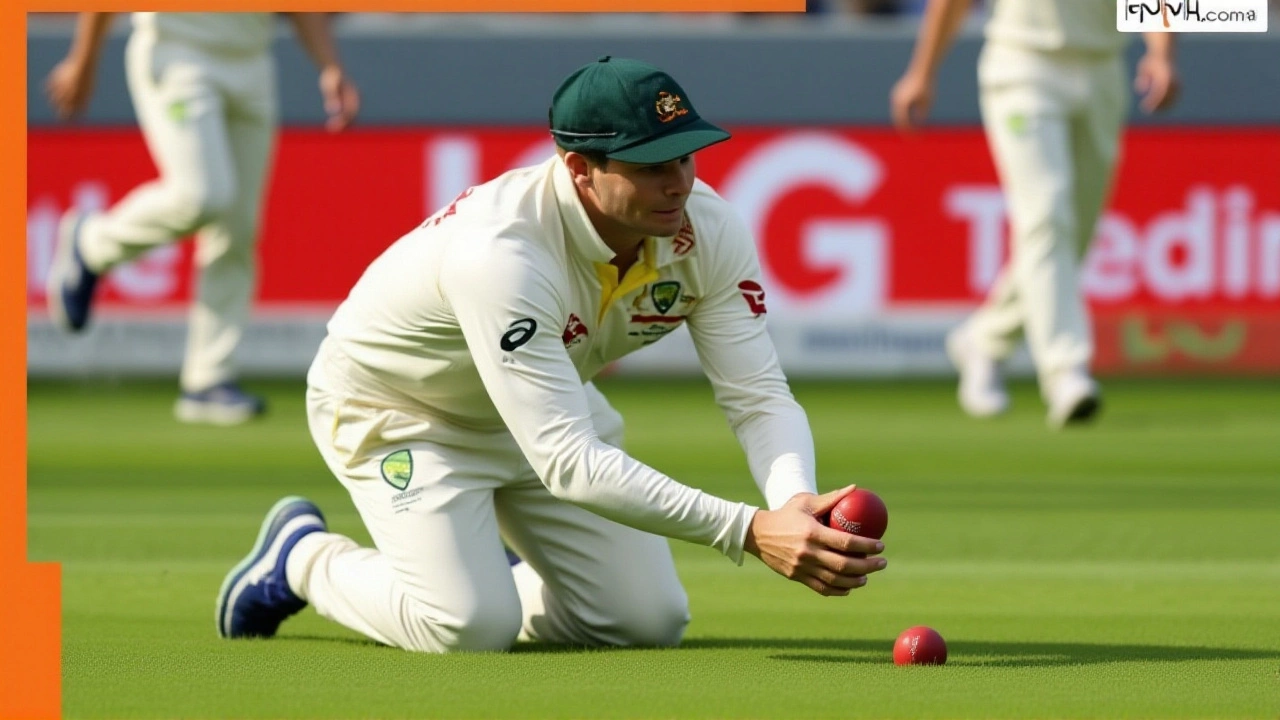On February 12, 2025, Steve Smith became the fifth Australian to join cricket’s elite 10,000-run club in Test cricket, reaching the milestone during Australia’s tour of Colombo. The 35-year-old right-handed batter, known for his unorthodox technique and mental toughness, brought up his 10,000th run with a single off Sri Lanka’s leg-spinner during Australia’s first-day innings — a quiet moment that echoed through cricket history. By the end of the day, Smith had 10,477 Test runs to his name, with a career average of 56.0 — the highest among all modern batsmen outside of Don Bradman. What made it more remarkable? He did it after a career-altering ban, a slump in form, and a public fall from grace — and still emerged as one of the most consistent run-scorers of his generation.
From Sandpaper Gate to the 10,000-Run Club
Smith’s journey to this milestone wasn’t linear. In March 2018, he was at the center of the infamous ‘Sandpaper Gate’ scandal in Cape Town, where he was caught on camera encouraging team-mates to alter the condition of the ball. The fallout was brutal: a 12-month ban from international cricket, a 9-month suspension from domestic play, and the stripping of his captaincy. For a man who had just led Australia to a dominant Ashes win in 2017-18, it felt like the end. But Smith didn’t disappear. He reappeared in domestic cricket, quietly rebuilt his technique, and returned to the Test side in 2019 with a renewed focus — and a new batting stance that confused bowlers for years.
By 2025, he was no longer just a comeback story. He was a statistical anomaly. In 120 Tests across 214 innings, Smith has averaged 56.0 — higher than legends like Sachin Tendulkar (53.78) and Jacques Kallis (55.37). His strike rate of 53.7 is unusually high for such a high average, meaning he scores quickly without sacrificing consistency. In 2025 alone, he amassed 515 runs in 10 innings at 51.5, including two centuries and two half-centuries — a sharp rebound from his 2024 season, where he managed just 490 runs at 35.00.
Surpassing Chappell, Chasing Border
Smith’s 10,477 runs now leave Greg Chappell’s 7,110 far behind — by over 3,300 runs. That’s not just a statistical leap; it’s a generational shift. Chappell, a dominant force in the 1970s, was once considered Australia’s greatest ever batsman before the arrival of Ponting and Waugh. Smith didn’t just surpass him — he redefined what Australian batting excellence looks like in the 21st century.
But he’s not done yet. Allan Border’s record of 11,174 Test runs still looms. Smith needs 697 more to become Australia’s second-highest run-scorer in Tests. At his current pace — roughly 500 runs per calendar year — he could reach it by the end of 2026, possibly before his 37th birthday. That would make him not only the most prolific Australian batsman of the post-Waugh era, but also the most consistent in terms of average and strike rate combined.

Captaincy, Contradictions, and Consistency
What’s often overlooked is Smith’s leadership. He captained Australia in 41 Tests, winning 24 — a 58.54% win rate that dwarfs Border’s 34.41% and even surpasses Steve Waugh’s 54.78%. His captaincy wasn’t loud or flamboyant; it was cerebral. He trusted his instincts, rotated bowlers with surgical precision, and often batted at No. 5 to stabilize the innings after early wickets. He led Australia to series wins in India (2019), England (2019), and South Africa (2021) — all tough venues.
Yet, his leadership wasn’t without controversy. After stepping down as ODI captain following the 2015 World Cup, he briefly returned to lead the T20I side in 2015-16, but his aggressive, risk-heavy approach didn’t always translate. Still, his Test captaincy record remains one of the most impressive in modern cricket — especially considering he took over during a turbulent period after the retirement of Waugh and Ponting.
The Numbers Don’t Lie
Smith’s 2025 Test season was a masterclass in resilience. He faced 19,517 balls in his career — more than 1,000 more than Ricky Ponting at the same stage. His 53 fours and 5 sixes in 2025 gave him a boundary percentage of 69.2%, meaning nearly seven in every ten scoring shots went to the ropes. His highest score? 239 against India in 2019 at the Adelaide Oval. His lowest? A duck in his debut Test against India in 2010. Yet, he’s been dismissed only 187 times in 214 innings — a testament to his ability to stay not out when the team needs him most.
Even his domestic record is staggering. In Australia’s One-Day Domestic Competition, Smith averages 58.09 — second only to Michael Bevan’s 61.18 among players with over 500 runs. He’s also scored 121 in the Big Bash League in January 2025, proving he can dominate in T20s too — something few of his 10,000-run peers can claim.

What Comes Next?
Smith’s next challenge isn’t just about numbers. It’s legacy. With Australia preparing for the 2026 Ashes in England, and with the likes of Travis Head and Marnus Labuschagne rising, Smith’s role may shift from anchor to mentor. But don’t count him out. He’s already defied expectations once — surviving scandal, rebuilding his game, and now standing just 700 runs from Australia’s all-time Test run record.
He’s not the flashiest player. He doesn’t celebrate wildly. He doesn’t need to. His bat does the talking. And right now, it’s speaking volumes.
Frequently Asked Questions
How does Steve Smith’s 10,000-run milestone compare to other Australian batsmen?
Smith is the fifth Australian to reach 10,000 Test runs, behind Ricky Ponting (13,378), Allan Border (11,174), Steve Waugh (10,927), and Matthew Hayden (8,625). His 56.0 career average is the highest among them, surpassing Ponting’s 51.85 and Waugh’s 51.06. Only Hayden’s average (47.65) is lower, making Smith statistically the most efficient of the five.
Why is Smith’s batting average considered so remarkable?
Among players with over 5,000 Test runs, only Sir Donald Bradman (99.94), Adam Voges (61.87), and Herbert Sutcliffe (60.73) have higher averages than Smith’s 56.0. He achieves this while facing over 19,500 balls and maintaining a strike rate of 53.7 — a rare blend of patience and aggression. Most high-average batsmen are slow; Smith scores quickly without sacrificing consistency.
What impact did the 2018 ball-tampering scandal have on his career?
The scandal led to a 12-month international ban and a 9-month domestic suspension. Smith lost his captaincy, faced public vilification, and was nearly ostracized. But he returned in 2019 with a revised technique, improved footwork, and a more disciplined mindset. His post-ban average of 57.8 (as of 2025) is higher than his pre-ban average of 54.2 — a rare case of a player improving after a career crisis.
Can Steve Smith realistically break Allan Border’s record?
Yes. Smith needs 697 more runs. At his 2025 pace of 515 runs per year, he could reach it by mid-2026. He’s still playing regularly, and with Australia’s schedule including tours of England and India in 2026, he has at least 8-10 Tests left before retirement. His form and fitness suggest he’s capable of achieving it, especially if he bats at No. 5 in key matches.
How does Smith’s performance in 2025 compare to his career norms?
In 2025, Smith averaged 51.5 in Tests with two centuries and two half-centuries in 10 innings — slightly below his career average of 56.0 but still elite. His boundary percentage jumped to 69.2%, indicating more aggressive shot selection. This contrasts with 2024, where he struggled with a 35.00 average and high false-shot rates. His 2025 rebound suggests he’s adapting his game for longevity.
Is Smith still a viable Test captain?
While he’s not currently captain, his 58.54% win rate in 41 Tests is the best among Australian captains with over 30 matches. His tactical acumen — particularly in managing spinners and setting fields — remains sharp. Many analysts believe he could return as captain in a limited-overs format or as a senior advisor during high-pressure Tests, especially if the current leadership falters.



